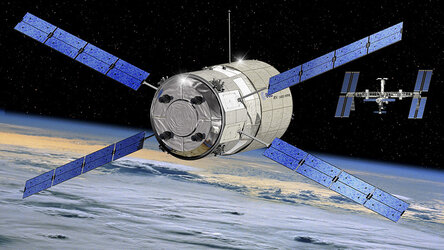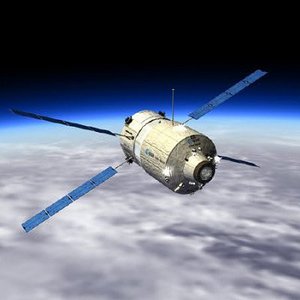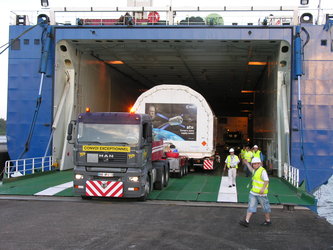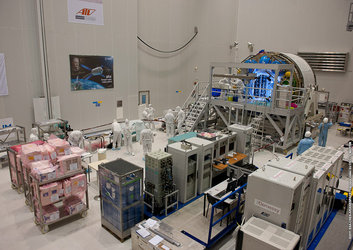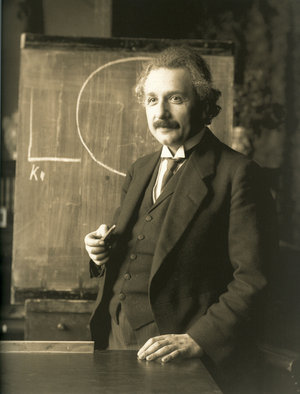ATV-3 set to provide ESA’s annual service to Space Station
PR 5 2012 - ESA’s third Automated Transfer Vehicle cargo ferry, Edoardo Amaldi, is ready for launch on an Ariane 5 to the International Space Station on 9 March from Europe’s Spaceport in Kourou, French Guiana.
The liftoff at 10:05 GMT (11:05 CET) will be covered live from Kourou for broadcasters and on the web, and followed at launch events around Europe.
ATV Edoardo Amaldi follows the two highly successful supply missions carried out by ATV Jules Verne in March 2008 and ATV Johannes Kepler in February 2011.

ATV-3 is named after the Italian physicist and spaceflight pioneer Edoardo Amaldi. A founding father of the European Space Research Organisation – precursor of ESA – and the European Organization for Nuclear Research (CERN), Amaldi is famous for being part of the group that discovered slow neutrons.
This third vessel in the ATV series is the first to have been processed and launched within the target rate of one per year.
This marks the start of ATV as an annual production-line supply vehicle for the Space Station, positioning Europe as an essential partner in operating the orbital outpost.
The next ATVs, Albert Einstein and Georges Lemaître, will follow in 2013 and 2014.
The spaceship will deliver essential supplies and propellant as well as reboost the Station’s altitude.
At more than 20 tonnes, the highly sophisticated spacecraft is the heaviest payload ever launched by Europe. It combines an autonomous free-flying platform, a manoeuvrable space vehicle and – when docked – a Space Station module.
To achieve an automated docking under the very tight safety constraints imposed by human spaceflight rules, ATV carries high-precision navigation systems, highly redundant flight software and a fully independent and autonomous collision-avoidance system with its own power supplies, control and dedicated thrusters.

The Space Station depends on regular deliveries of experiment equipment and spare parts, as well as food, air and water for its crew.
Since 2008, every year and a half, an ATV has delivered about 6 tonnes of cargo some 400 km above Earth.
After launch on an Ariane 5 from Europe’s Spaceport in French Guiana, ATV automatically navigates to a precision docking with the Station’s Russian Zvezda module.
It remains attached to the ISS for up to six months before reentering the atmosphere and deliberately burning up together with several tonnes of Station waste.
About 10 m long and with a diameter of 4.5 m, ATV incorporates a 45-cubic metre pressurised module and a Russian docking system, similar to those used on the Soyuz manned ferries and the Progress supply ships.
With its solar wings deployed, ATV spans 22 m. Almost three times larger than Russia’s Progress, it can also deliver about three times the cargo load.
Propellant and cargo for the Station

ATV is the largest supply ship to travel to the International Space Station since the US Space Shuttle fleet was retired last year. ATV-3 will deliver 4395 kg of propellant, oxygen, air and water to the Station.
Once docked, the propellant will be used by ATV’s own thrusters to raise the Station’s orbit periodically to compensate for the natural decay caused by atmospheric drag.
ATV can also be used to move the Station out of the way of potentially dangerous space debris that come too close to the manned space complex.
Before leaving the Station, Edoardo Amaldi will be filled with waste bags and unwanted hardware by the crew.
It will then be deorbited over the southern Pacific Ocean to burn up harmlessly in the atmosphere.
Astrium is the industrial prime contractor, leading a team of more than 30 contractors in 10 European countries. The ATV Control Centre is located in Toulouse, France, on the premises of the French Space Agency, CNES.
For more information about ATV please visit http://www.esa.int/ATV
Notes for Editors
The launch video transmission will be available live on www.esa.int
Background media briefings
In France, a pre-launch media encounter will be held in cooperation with the national space agency, CNES, on 6 March.
In Spain, a pre-launch media encounter will be held at ESAC, on 9 March, the day of the launch.More information is available at http://www.esa.es/
Launch events
Launch events will be organised at the main ESA establishments in France (ESA HQ, Paris), Germany (ESOC, Darmstadt), Italy (ESRIN, Frascati), the Netherlands (ESTEC, Noordwijk), and Spain (ESAC, Madrid).
Media wishing to attend are invited to contact:
- ESA HQ: clare.mattok@esa.int
- ESOC: Nicola Gebers, esoc.communication@esa.int +496151902516
- ESRIN: franca.morgia@esa.int
- ESTEC: estecpr@esa.int
- ESAC: comunicacionesac@esa.int
In addition, in Germany, in cooperation with DLR and EADS Astrium, a launch event for the launch will take place at the Astrium facilities in Bremen. Media willing to attend must register at : presse@astrium.eads.net.
More information about the event can be obtained by contacting EADS Astrium Communication, Kirsten Leung at +49 4215 395326.
Due to security reasons it is necessary to identify yourself by a valid ID-Card or Passport. Press cards will not be accepted.
Material for online news sites
The launch video transmission will be available for all interested online media as an embeddable livestream at http://www.livestream.com/eurospaceagency/
Online media outlets can find background videos at:
- ESA online video archive: http://multimedia.esa.int/
- Broadcast standard (MPEG 2) on the FTP server at: http://television.esa.int/default.cfm
Still images
The latest high-resolution still images can be found at:
- Multimedia Gallery: http://www.esa-photolibrary.com
Media image queries can be directed to esa.photolibrary@esa.int
Material for broadcasters
Leading up to launch day, ESA TV will be providing broadcasters with a series of video news releases and B-rolls featuring all aspects of the mission.
The launch will be transmitted live from Kourou via satellite. All details can be found on ESA TV’s site at: http://television.esa.int
For further information, please contact:
ESA Media Relations Office
Communication Department
Tel: + 33 1 53 69 72 99
Fax: + 33 1 53 69 76 90
Email: media@esa.int



